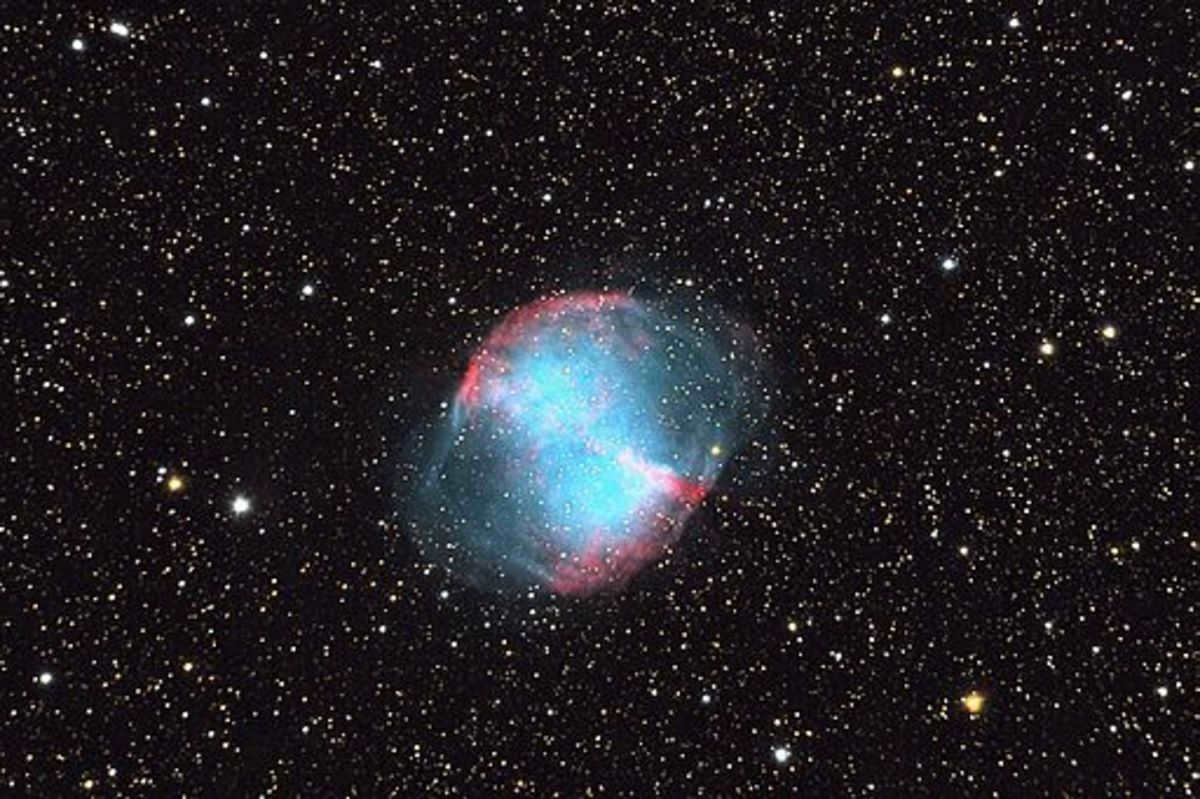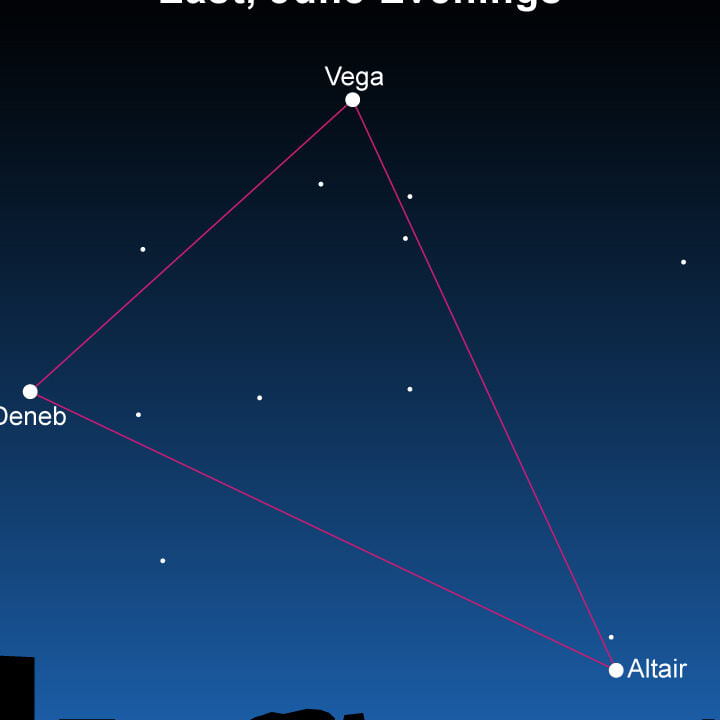From July to late autumn, you can see three bright stars in the southern sky in the evenings. These stars create the most famous constellation in the summer night sky, known as the Great Summer Triangle. The area of the sky where this constellation is located is extremely fascinating. The Summer Triangle intersects with a hazy trail of the Milky Way, and even with binoculars, you can see stunning images of star clusters and dark nebulae. When you venture outside the city, you will be able to observe numerous scattered star clusters, a few globular star clusters, beautiful double stars, and even some nebulae through a telescope.
The sheer abundance of stunning celestial entities found in this particular region of the sky is so vast that it would necessitate an entire tome to adequately depict them. However, a considerable number of these entities necessitate a level of expertise in astronomical observation, specialized instruments, and favorable atmospheric conditions. Consequently, they may fail to elicit a profound impression on novice enthusiasts armed with their unassuming equipment. So, for those who are new to the art of observing objects within the stellar realm, where does one commence? I have compiled a selection of eight entities that can be observed using the unaided eye, binoculars, or a diminutive telescope from the outskirts of a city or a countryside retreat.
Item No. 1. Vega
Vega, the most radiant star in the Summer Triangle, occupies the upper right corner of this asterism and can be found almost directly above during summer evenings. Don’t forget to train your binoculars or telescope on this celestial object! Observe Vega using the lowest possible magnification to ensure a wide field of view. You will witness Vega as a brilliantly shining bluish-white star, accompanied by distant background stars of 9th and 10th magnitude that twinkle like sparks. The luminosity of Vega can be likened to the splendor of a sapphire – an incredibly mesmerizing sight!
Object #2. The constellation Lyra
Vega leads the small constellation Lyra, which is primarily characterized by a small parallelogram comprised of stars with magnitudes ranging from 3 to 4. This parallelogram is situated directly below Vega and can be observed in its entirety or nearly so through binoculars. Take a close look – the stars within the parallelogram display a range of colors, from red to blue. Each star also has neighboring companion stars. Additionally, there are numerous faint stars surrounding and within the parallelogram.
The region encompassing β and γ Lyra, which form the lower base of the parallelogram, is particularly intriguing. Firstly, the beta star of Lyra is a renowned eclipsing variable star, with its luminosity fluctuating by an entire stellar magnitude (2.5 times!) over a 13-day period. Secondly, this area is home to the celebrated planetary nebula known as “the Ring” or M57. Positioned halfway between gamma and beta Lyra, the nebula can be located here.
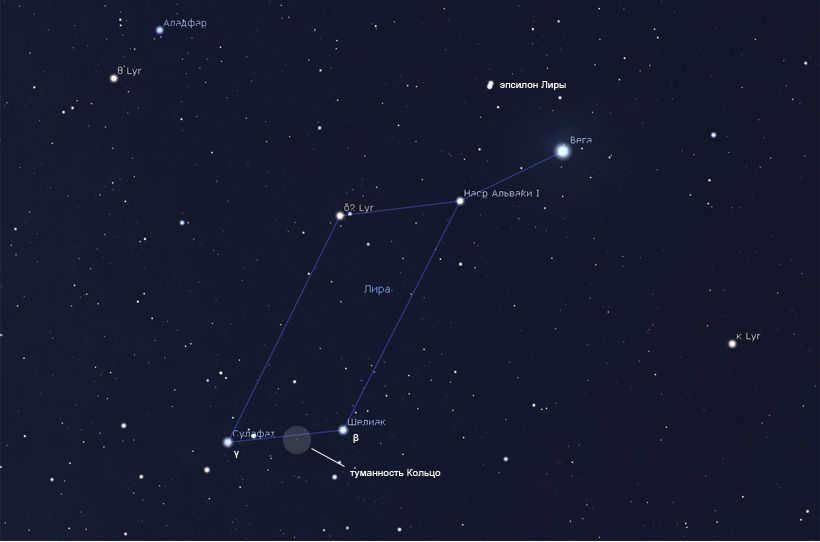
The constellation Lyra. Image: Stellarium
Located to the left of Vega (above the parallelogram) is the most intriguing binary star, epsilon Lyra. Its dual nature can be observed even without any optical aids by individuals with exceptionally keen eyesight. When viewed through binoculars, it becomes apparent that Lyra epsilon is composed of two closely positioned white stars. By utilizing a telescope with a lens larger than 70 mm, one can discern that each of the components of Lyra’s epsilon is, in fact, comprised of two stars (higher magnifications are necessary to separate the stars.).
Thus, Lyra epsilon is a quadruple star system or, as it is often referred to by amateur astronomers, a “double double”.
Object #3. Deneb and its surrounding area
The third item for the initial introduction is Deneb star. It occupies the upper left corner of the Great Summer Triangle. During summer evenings, it can be seen at the same height in the sky as Vega.
Deneb is the least luminous among the three stars of the triangle, but it is also the farthest. Its distance exceeds two thousand light years. If this star were positioned at the same distance from us as Vega, it would emit light several tens of times brighter than Venus! Its light would create distinct shadows on objects!
Deneb is located in the densest section of the Milky Way, where the path of the nebula divides into two wide arms, separated by interstellar dust. To fully appreciate Deneb’s surroundings, it is best to observe with binoculars away from the city lights. The sheer concentration of stars in this area is truly astonishing! Throughout this region, stars can be seen clustering together in groups and forming chains, with some surrounded by a faint haze – these are the dimmer stars that blend into the background. However, the prominent presence of Deneb remains the focal point in this entire scene.
Object #4. The Swan constellation
The Swan constellation is one of the most stunning constellations in the night sky! While it may not shine as brightly as Orion, its beauty is equally captivating. To witness the full splendor of this constellation, wait until nightfall and find a location away from the overpowering glow of city lights.
The primary shape of the Swan constellation is a cross formed by five stars. At the top of the cross is Deneb, which also happens to be the brightest star in the constellation. Just below Deneb is the gamma star of the Swan, the second brightest in the cross. On either side of the gamma star are two more stars of similar brightness, creating the center and crossbar of the cross. Finally, the base of the figure is marked by the enchanting double star Albireo (or β Swan), the faintest among the five stars.
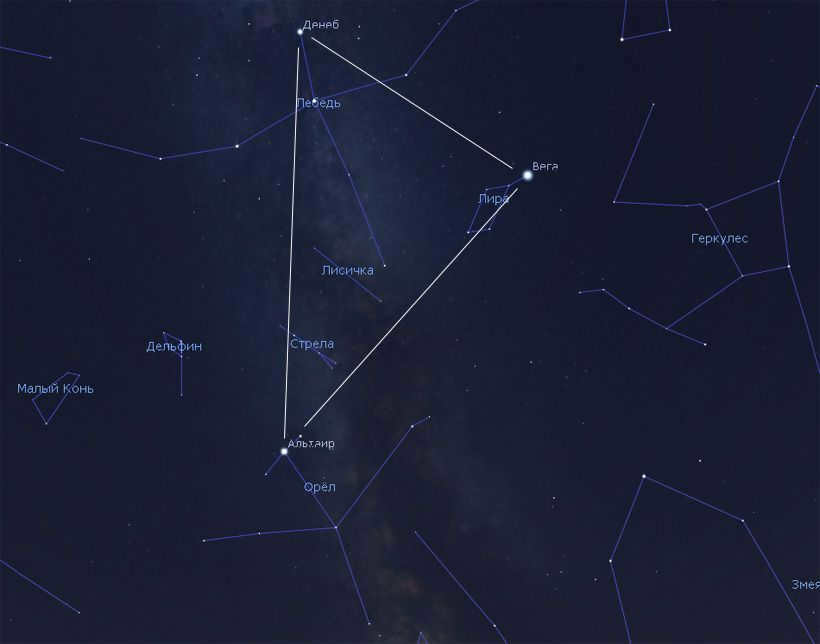
The magnificent Summer Triangle. Take note of the constellation Cygnus, which bears a striking resemblance to a bird in flight. Image: Stellarium
In earlier times, this celestial formation was known as the Northern Cross; once you have observed it at least once, you will be able to easily locate the Northern Cross in the night sky. The method for locating it is quite simple: the faintest of the three stars comprising the Summer Triangle (Deneb) serves as both the apex and the brightest star of the Northern Cross.
The Northern Cross is an exquisite asterism, but upon closer inspection of the surrounding stars ε and δ, one can discover fainter stars that appear to extend the horizontal beam both to the right and left, simultaneously curving it upwards… It doesn’t take a vivid imagination to envision a colossal bird soaring downwards towards the horizon within this formation. In this perspective, Deneb is no longer the pinnacle of the cross, but rather the bird’s tail, while the star Albireo becomes its head, separated from the body by a lengthy neck! This represents the depiction of the Swan constellation.
Once you have observed the constellation with the naked eye, explore it further with binoculars – from Deneb to Albireo and along the wings. Within your field of view, you will witness entire clusters of stars, resembling a shimmering display of diamond dust.
Object #5. Albireo
Without a doubt, we couldn’t overlook Albireo, which happens to be one of the most stunning binary stars in the night sky. Albireo is effortlessly observable and can be clearly distinguished even with 30mm binoculars, not to mention a telescope.
What makes this star particularly captivating for astronomy enthusiasts is the remarkable color of its components. The primary star shines with a radiant golden yellow hue, while its companion gleams in a mesmerizing shade of blue, creating a striking contrast. The closer these stars are to each other, the more pronounced the color contrast becomes, so it’s advisable to avoid using high magnifications if you wish to fully appreciate the sheer beauty of this celestial object.
Object #6. Asterism Hanger
Many individuals who have an interest in astronomy enjoy taking leisurely strolls with binoculars around the Summer Triangle, not with any specific purpose in mind, but simply for their own enjoyment. If you decide to follow in the footsteps of these amateurs (it would be beneficial to venture outside of the city to fully appreciate this section of the sky!), you will soon stumble upon a peculiar and delightful formation consisting of ten stars, each with a magnitude of 5-6. These stars are not only arranged closely together, but also in a very organized manner: six stars extend in a straight line from east to west, while another four stars form a hook, bending downwards towards the south. When viewed as a whole, these stars remarkably resemble an inverted clothes hanger.
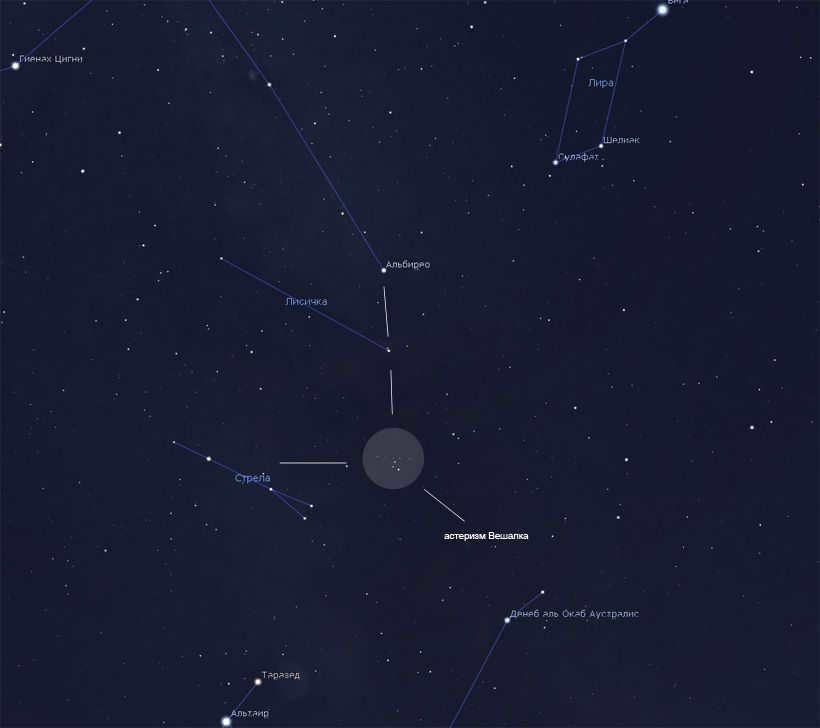
The position of the Hanger asterism in the night sky can be seen in the above figure from Stellarium.
The Hanger asterism, also known as Collinder 399, can be found to the south of the star Albireo and to the right of the compact constellation Arrow. Previously, astronomers thought that Collinder 399 was a clustered group of stars due to its close proximity and similar brightness. However, further examination revealed that the stars of Collinder 399 are actually unrelated and only appear close together when viewed from Earth.
Make sure to observe this unique asterism using binoculars that have a wide field of view. The “Hanger” is also easily visible in the urban sky.
Object #7. Dumbbell Nebula
Another remarkable object can be found to the left of the “Hanger”, forming an equilateral triangle with this asterism and the star Albireo. This is the renowned planetary Dumbbell Nebula, also referred to as object M27 in Charles Messier’s catalog. The Dumbbell Nebula can be clearly seen using binoculars with an aperture of 50 mm or larger, as well as through any telescope.
To locate the nebula, it is most effective to observe it from the previously mentioned Arrow constellation. The Dumbbell nebula, also known as M27, can be found 3° north of the star γ in the Arrow constellation, which is the brightest star in the constellation and serves as a reference point. When viewed through small binoculars, the Dumbbell nebula appears as a slightly blurred rectangular shape. However, when observed through larger binoculars or telescopes, the nebula takes on the form of an hourglass or dumbbell.
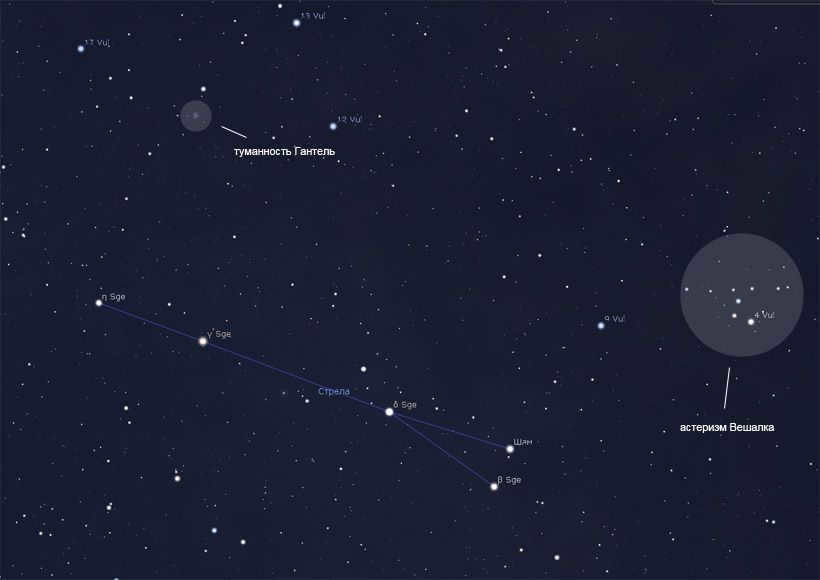

The Dumbbell Nebula, also known as M27, can be found 3 degrees to the north of the star γ Arrow. See the figure from Stellarium for reference.
M27 is a remarkably bright nebula that can even be seen from the outskirts of large cities, as long as the night sky is clear and the observation site is shielded from the light of street lamps. In telescopes with an aperture larger than 70 mm, you may notice that the brightness of M27 is not consistent throughout the “hourglass” shape. However, observing these variations requires a dark and clear sky.
It is worth mentioning that the Hanger asterism and the Dumbbell Nebula can be found in the Foxy, a minuscule constellation that is situated completely within the Great Summer Triangle. Foxglove lacks any notable bright stars and does not possess a recognizable shape. However, it is quite captivating to observe through binoculars and small telescopes.
Object #8. The Milky Way
The final item on the inventory is the Milky Way. This celestial pathway descends in a grand manner from Deneb to Altair. As mentioned earlier, it divides near Deneb into two expansive streams, separated by obscure interstellar dust. The left border traverses through the constellations of Cygnus and Sagitta, leading to Altair, while the right border, intersecting the constellation Lyra, descends in a southerly direction, following the gamma star of Cygnus, towards Albireo, and even further down to the zeta of Aquila.
Regrettably, merely stepping outside of a city is no longer sufficient to fully appreciate the beauty of the Milky Way. One must locate a location that is situated at least within the green light zone.
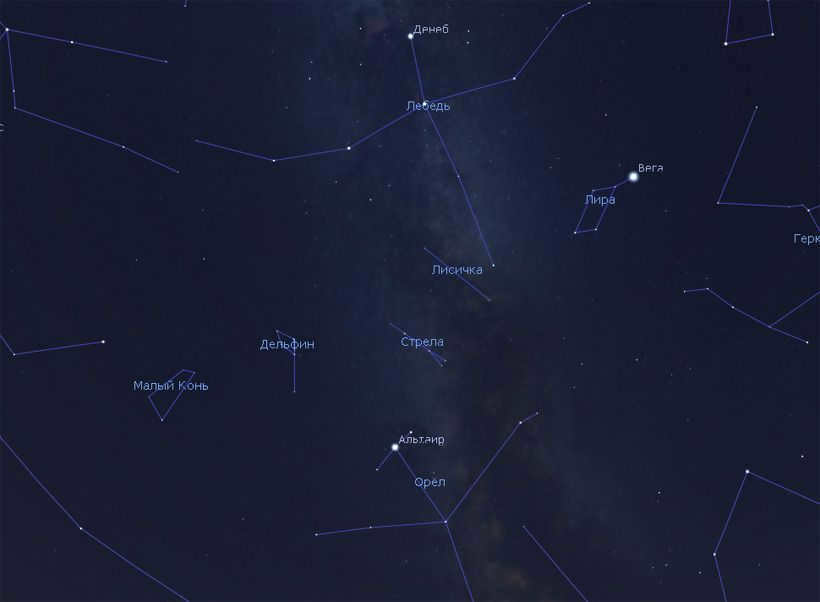
The Great Summer Triangle, which includes the Milky Way, is the dominant constellation in the summer night sky. This stellar pattern is a popular subject of interest among beginner stargazers, who often wonder how to navigate the vastness of the celestial sphere.
The solution is straightforward: gradually! Initially, you must acquire the skill of identifying the most brilliant stars in the celestial sphere and familiarize yourself with their designated names. Subsequently, progress from individual stars to constellations and acquaint yourself with the positions and names of the most prominent and distinctive star formations. Once accomplished, you can then proceed to utilize a star chart. Without prior knowledge of the locations of the brightest stars in the sky, it becomes arduous to master celestial navigation using maps (unless utilizing a planisphere) – as you lack reference points in the heavens to compare with the information presented in the atlas.
That is the reason why we will begin with the most basic of observations. Step outside on the closest evening with suitable weather conditions, position yourself so that you are facing towards the south, and direct your gaze upwards. You may be wondering: Where exactly is south? South is the direction where the Sun is located in your specific region at approximately noon. At this moment, it is not necessary for you to have an exact understanding of the precise southward direction, although you will be able to determine it later on with the assistance of Polaris.
Therefore, once evening twilight has arrived, position yourself so that you are facing south and then elevate your head. In the upper regions of the sky, you will be able to observe a large triangle that is composed of three highly luminous stars.
During the month of July, as nightfall descends upon us, the Great Summer Triangle can be found in the southern portion of the sky. Image: Stellarium
The upper right apex of the triangle is formed by the brightest star. Even in a relatively bright twilight sky, you will notice it. It is Vega, the brightest star in the northern hemisphere of the celestial sphere following Arcturus. The upper left vertex is formed by the star Deneb. It is much dimmer than Vega but still one of the brightest stars in the night sky. Finally, the third star, Altair, lies below these two stars. Its brightness is intermediate between Deneb and Vega.
The stars Vega and Deneb, which form the base of the triangle, will be located almost at the zenith. The apex of the triangle, indicated by the star Altair, is about halfway from the zenith to the horizon – the triangle appears to be inverted, it “looks” downward.
Before you is a well-known star pattern in our sky known as the Great Summer Triangle or the Summer Triangle, and sometimes referred to as the Summer-Autumn Triangle. It is most easily observed during the summer and fall months when it appears high in the southern part of the sky during the evenings.
Having knowledge of this star formation is beneficial for several reasons.
- By studying it, you can familiarize yourself with all the summer constellations individually.
- The Milky Way intersects with the Summer Triangle, with the star Deneb located within it. Therefore, if you locate the Summer Triangle in the sky, you will also be able to identify the position of the Milky Way.
- Within and surrounding the edges of the Summer Triangle, there are numerous celestial sights to behold, such as diffuse nebulae, diffuse and globular star clusters, as well as double and variable stars.
The Summer Triangle is not a constellation, but rather an asterism. It is a figure and a pattern made up of stars from three different constellations. Lyra is represented by Vega, the Swan by Deneb, and the Eagle by Altair. These ancient constellations have been visible in the country sky for over 2000 years, particularly during dark August or September nights.
If you are new to exploring the celestial realm, make sure to locate the Great Summer Triangle – it will serve as your foundational stellar formation until October comes to a close.
The Summer Triangle is a grouping of three stars from distinct constellations
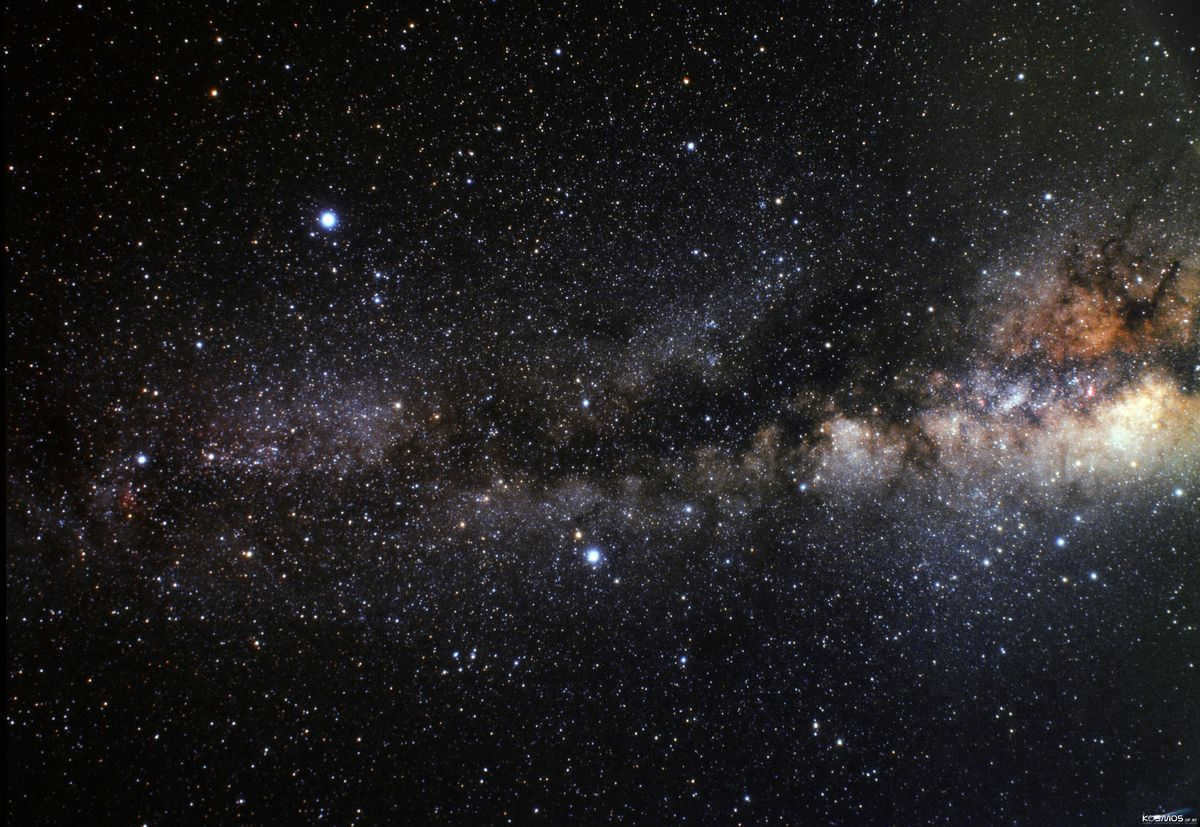
The Summer Triangle is a collection of constellations in the Northern Hemisphere that have the same brightness and unique shape. Unlike most constellations, it is made up of three separate constellations: Altair, Vega, and Deneb. Deneb is the farthest from Earth and is the main star in the Northern Cross asterism and the brightest in the Swan constellation. Vega, on the other hand, belongs to the small and dim Lyra constellation and is the brightest object in it. It is likely one of the brightest stars in the entire night sky. The closest bright star to Earth is Altair, which is part of the Eagle constellation. It is the third star in the Summer Triangle.
For a considerable period of time, it was widely held that all of these celestial bodies possessed identical luminosity, despite their varying distances from Earth: Deneb – 1400 light-years away, while Altair and Vega – only 20 light-years away. This discrepancy in brightness between Deneb and the others is readily apparent.
The summer triangle was initially depicted on star maps by Johann Bode in the early 19th century, albeit without a designated name. It took over a century for this asterism to be identified and named by Oswald Thomas of Australia in his writings. The term gained further popularity in the 1950s thanks to the efforts of English astronomer Patrick Moore and Ray H.A. from the United States.
Last year, Vega unveiled its previously unnoticed asteroid belt, providing astronomers with a hint that there may be nearby planets. At the poles of Vega, which rotates rapidly (every 12.5 hours), the temperature is thousands of degrees higher compared to the equator. Even a slight increase of 10% in its rotational speed could lead to the destruction of the star. Since 2006, Altair has been known to have a slight flattening at its poles and a relatively high rotational speed. Astronomers consider Deneb as a potential candidate for a supernova.
Summer-Autumn Triangle in the Asterism
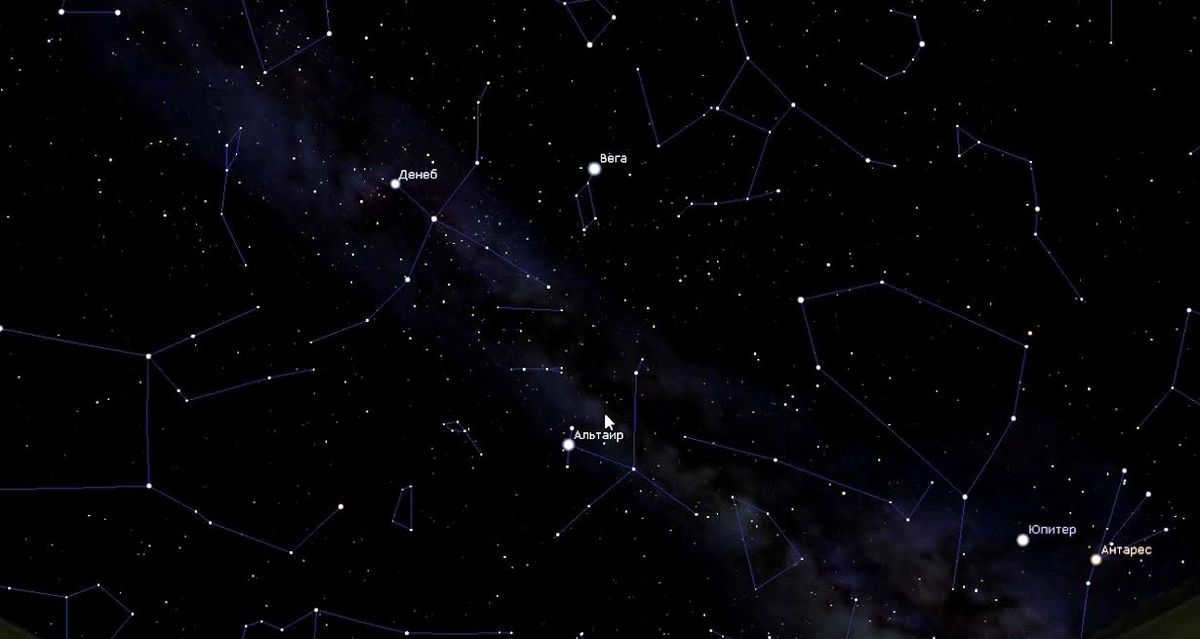
The asterism known as the Summer-Autumn Triangle consists of the stars Vega, Altair, and Deneb. These three stars are the most luminous in the constellations of Lyra, Eagle, and Swan, respectively. The Summer-Autumn Triangle, which features three stars of the first magnitude, is a prominent feature in the summer night sky of the northern hemisphere. It serves as a useful guide for identifying these three bright stars and their corresponding constellations, as well as for locating various bright celestial objects that can be found in this particular region of the sky.
The asterism can be seen for the majority of the year by those in the northern hemisphere, but it becomes particularly noticeable in the summer months when it ascends high in the sky during the evening. Although the asterism has been recognized for a long time, it did not gain widespread usage of its name until the 1950s, when the British astronomer Sir Patrick Moore and the American author H. A. Ray popularized the term. It was previously utilized by the military as a means of orientation prior to the invention of GPS systems and other navigation devices.
Position in the celestial sphere
The summer-fall triangle is positioned directly above during the summer months in the northern hemisphere. This group of stars can be observed for most of the year from locations north of the equator, but its location in the sky varies depending on the time of the year. In the spring, it can be spotted in the eastern sky during the early hours of the morning. In the fall, it can be seen in the western sky during the evening. Observers in southern latitudes can catch a glimpse of it during the winter, when it appears low over the northern horizon. Interestingly, when observed from locations in the southern hemisphere, the summer-fall triangle appears flipped upside down.
In the vast expanse of the Milky Way, one can find the summer and fall triangle. This region of the sky is marked by the prominent stars Vega, Altair, Deneb, as well as other bright stars belonging to the constellations of Lyra, Eagle, and Swan. These stars serve as guideposts for astronomers searching for various deep space objects in this area. Notable objects include the NGC 7000 and IC 5070 emission nebulae, the Messier 57 (Ring Nebula) and Messier 27 (Dumbbell Nebula) planetary nebulae, the Messier 56 and Messier 71 globular clusters, and the Messier 11 (Wild Duck Cluster) and Messier 26 scattered clusters.
Noteworthy Stars of the Summer-Fall Triangle
The Summer-Fall Triangle showcases three prominent stars that are among the most luminous in the entire sky. They possess apparent magnitudes of 0.026 (Vega), 0.76 (Altair), and 1.25 (Deneb). Vega, the fifth brightest star in the sky, holds the distinction of being the second brightest in the northern celestial hemisphere, only surpassed by Arcturus. Altair, on the other hand, ranks as the twelfth most brilliant, while Deneb secures the nineteenth spot.
Vega and Altair emanate an extraordinary radiance due to their proximity to Earth. Vega is a mere 25.04 light-years away, and Altair resides even closer at a distance of 16.73 light-years. Although still confined to the main sequence, these two stars do not radiate as intensely as the supergiant Deneb, which illuminates the cosmos at a staggering magnitude and is positioned approximately 2,615 light-years from our planet.
All three stars exhibit slight variations in their brightness. Vega and Altair are categorized as Delta Shield variables, which are stars that experience changes in brightness due to both radial and non-radial pulsations on their surfaces. Deneb, on the other hand, is the prototype for a unique class of variable stars called Alpha Swan variables. These stars, typically A or B type supergiants, undergo small yet rapid fluctuations in brightness as a result of non-radial pulsations, where certain parts of their surface expand while others contract.
All three stars have names that are related to birds. The name Vega is derived from Arabic and translates to “falling eagle”. Altair, also of Arabic origin, means “flying eagle”. As for Deneb, its name means “tail” and refers to the tail of the celestial Swan.
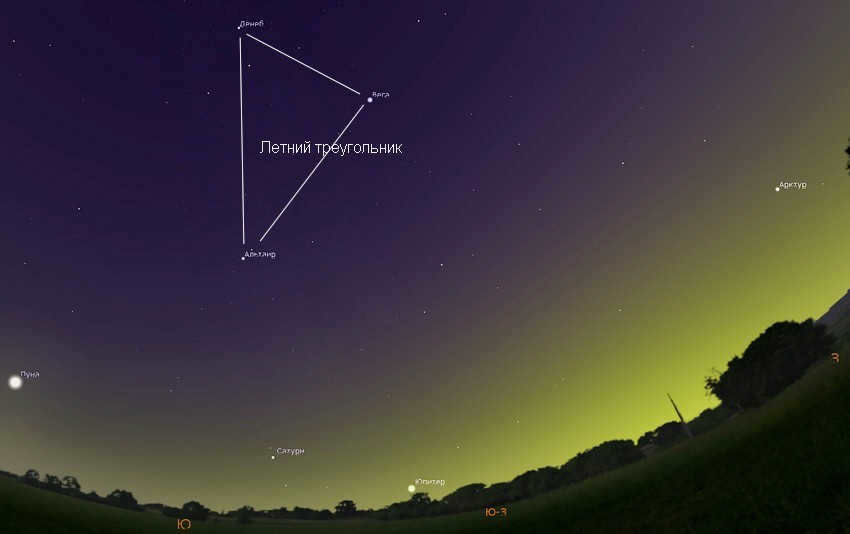
Mythology
The legend of the Weaver Girl and the Shepherd, which is commemorated during the annual Qixi Festival in Chinese mythology, is closely associated with Vega, Altair, and Deneb. According to the story, Altair represents the shepherd, who is an orphan, and Vega represents the Weaver Girl. They fall in love and get married, but their union is forbidden by the emperor of heaven, who sends the weaver to heaven. The couple is only able to meet once a year, when magpies create a bridge across the Milky Way. In some versions of the tale, Deneb serves as the marker for the magpie bridge, while in others, Deneb symbolizes the fairy who accompanies the couple during their reunion. The two stars flanked by Altair, Tarazed and Alshain, represent the children of the couple.
Triangles can be found throughout the sky. The large summer triangle dominates the evening sky from July to October. The Triangle constellation is visible in the autumn sky… The triangle is such a simple shape that it can be seen wherever there are relatively bright stars. You can look at the spring sky, connect its three brightest stars, Arcturus, Spica, and Regulus, and possibly create the largest triangle in the sky. However, this is rarely done due to the large angular distance between the stars.
One of the most mysterious asterisms is the Winter Triangle, which can be observed in the sky from November to March. It consists of three brilliant stars – Sirius from the Big Dog constellation, Procyon from the Lesser Dog constellation, and Betelgeuse from the Orion constellation.
The configuration of stars known as the Orion constellation is truly a remarkable sight. Positioned at its core are three rather luminous stars aligned in a straight formation – commonly referred to as Orion’s Belt. The remaining prominent stars within Orion are symmetrically paired on either side of the belt.
Displayed above is an image showcasing the winter constellations, including Orion’s Belt and the Winter Triangle. Image: Stellarium
Orion’s Belt serves as a guide to locate two noteworthy celestial objects in the winter sky. Extending the belt line towards the horizon will lead you to Sirius, the most brilliant star visible during the night. Conversely, tracing the belt in the opposite direction will bring you to the Pleiades, a stunning dispersed star cluster resembling a small dipper.
The Winter Triangle can be found in close proximity to Orion’s Belt. One of its defining points is the star Betelgeuse, which is located in the upper right corner of the figure. Betelgeuse stands out from the other stars in Orion due to its striking deep red color. Another star that is part of the Winter Triangle is Sirius, which is known for its exceptional brightness and frequent twinkling. Sirius often dazzles observers with its ever-changing array of colors.
Lastly, the third star that completes the Winter Triangle is Procyon. It can be found in the upper left corner of the figure. Procyon serves as the leading star in the Lesser Dog constellation, where it is accompanied by only one other relatively inconspicuous star.
The Winter Triangle, along with the constellation of Orion. Photo: Bob King
What lies within the Winter Triangle? When gazing upon the urban sky, one will find absolutely nothing within. However, in the countryside, scattered about will be a few dozen faint stars, twinkling in the frigid air like distant city lights. These stars are part of the Unicorn constellation, the least bright winter constellation. Yet, with the aid of a telescope, one can discover numerous intriguing entities within the Unicorn – various nebulae and luminous star clusters.
Stretching through the Unicorn constellation and the Winter Triangle is a strip of the Milky Way. In this portion of the sky, the Milky Way, although expansive, is much more delicate and faint compared to its appearance in the summer sky. Therefore, venturing away from urban areas is necessary to observe it.
Within the Winter Triangle lies the Unicorn constellation. A segment of the Milky Way passes through the Winter Triangle. Figure: Stellarium
Why did I mention earlier that the Winter Triangle is a rather inconspicuous shape? The reason is that you can create numerous triangles like this in the winter sky. For instance, you can form a triangle using Rigel, Betelgeuse, and Aldebaran. Alternatively, you can connect Rigel, Betelgeuse, and Sirius to create a triangle. In reality, there is a larger pattern in the winter sky known as the Winter Hexagon or Winter Circle, which brings together all the brightest stars of winter, except Betelgeuse. It seems like someone felt that this star was being treated unfairly and decided to invent a specific shape just for it. Do you have any other suggestions?
Regardless, I encourage you to locate the Winter Triangle in the sky – it may come in handy for celestial navigation!
THE “CONSTELLATION OF THE PLEIADES” OR WHAT IS ASTERISM
Published 04.12.2011 // ARTICLES
What exactly is an asterism? It is quite common to hear phrases like “the Big Dipper constellation” or “the Pleiades constellation”, but in reality, these constellations do not actually exist! The majority of people on Earth may not be aware of this fact. However, notable star groups such as the Big Dipper and Little Dipper, the Square of Pegasus, the Summer-Autumn Triangle, Orion’s Belt, the Pleiades star cluster, the letter “W” of the Cassiopeia constellation, and many others are actually referred to as asterisms.
Asterisms hold a certain significance that surpasses that of the constellations. For instance, when locating Polaris, astronomers typically rely on the distinct Big Dipper asterism, which then leads them to the Small Dipper, and ultimately, the Polaris can be easily identified on the handle of the Small Dipper. Similarly, the constellation Cancer, which is rather unremarkable on its own, gains recognition due to its association with the asterism Crèche, which is a constituent part of Cancer and is also part of the Zodiac belt.
Ursa Major
Ursa Major – part of the constellation Ursa Major. Perhaps the most well-known asterism.
Ursa Minor
The second most renowned asterism in the constellation. Ursa Minor, which facilitates the identification of Polaris.
The most notable asterism in the northern hemisphere is composed of three highly luminous stars found in three different constellations. These stars are Vega in the constellation Lyra, Deneb in the constellation Cygnus, and Altair in the constellation Aquila.
Winter triangle
The winter triangle is a prominent feature in the winter sky of our latitudes. It includes the brilliant star Sirius in the constellation Canis Major, Procyon in the constellation Canis Minor, and Betelgeuse in the constellation Orion. By adding the stars zeta from the constellation Corvus and Alpha Columbae, a different asterism is formed– the Egyptian Cross.
The Asterism Winter Triangle is a constituent part of another asterism called the Winter Circle. Along with the previously mentioned stars Sirius, Procyon, and Betelgeuse, this asterism also includes Pollux and Castor from the constellation Gemini, Menkalian and Capella from the constellation Ascendant, Aldebaran from the constellation Taurus, and Rigel from the constellation Orion.
The Spring Triangle
Similar to all triangles, the Spring Triangle consists of stars located near the equator. It becomes visible in the spring season in the northern latitudes. It is comprised of the star named Arcturus from the constellation Boötes, Spica from the constellation Virgo, and Denebola from the constellation Leo. Additionally, if we include the star called Cor Caroli from the constellation Canes Venatici, the resulting shape would be a rhombus known as the Virgo Diamond (or sometimes referred to as the Virgo Necklace) – which is also considered as an asterism.
The “W” of Cassiopeia
This group of stars, known as Cassiopeia, is one of the most easily recognizable in the night sky. The five stars that form this constellation are arranged in the shape of a distinct Latin letter “W”.
The Great Square
After exploring the triangles, we move on to the squares. This group of stars is commonly referred to as the Great Square of Pegasus, as it includes not only the three stars of Pegasus but also one star from the constellation Andromeda. Together, these stars form a nearly perfect square that is simple to locate. Although all four stars were once part of the Pegasus constellation, the star Alferatz now belongs to Andromeda.
The Three Stars of Orion’s Belt
The trio of stars that form a straight line in the constellation Orion are readily identifiable in the celestial sphere, and they serve as a helpful guide for locating the constellation Orion in the northern hemisphere. Throughout history, these three stars have been referred to as the three wise men or Magi in various cultures.
The Tail of Scorpio
There is a group of stars in the constellation Scorpio that forms an asterism. This asterism includes one of the most luminous stars in the sky, known as Antares. At the very end of Scorpio’s tail, there are two stars that have their own name – Cat’s Eyes.
The Pleiades Star Cluster
As previously mentioned, the Pleiades star cluster is often referred to as “the constellation of the Pleiades” due to its romantic name. In reality, it is the closest cluster of stars to Earth and can be easily seen with the naked eye in the constellation of Taurus. The Pleiades are named after the seven sisters, who were the daughters of Atlanteus according to Greek mythology.
The Hyades is a star cluster in the Taurus constellation that is slightly less prominent than the Pleiades. Aldebaran, which is not part of this cluster, forms a distinct “V” shape with the Hyades. These stars are also known as the daughters of the prolific Atlantean half-sisters, the Pleiades.
Northern Cross
The luminous stars of the constellation Cygnus create a distinctive pattern that extends across the Milky Way. This pattern is known as the Northern Cross. It can be seen throughout the year in our latitudes, but it is most prominent during the summer and early autumn. The star Deneb, which is a component of the Northern Cross, is also a part of the summer and autumn triangle.
Deceptive Southern Cross.
An untrustworthy arrangement of stars in the southern hemisphere that has often led sailors astray. Consisting of four stars from the constellations of Sails and Kiel, this false Southern Cross does not indicate the direction south.
Medusa’s severed head
An irregularly shaped quadrangle in the constellation Perseus that is commonly associated with the decapitated head of Medusa Gorgon, which is held in Perseus’ hand. The brightest star of this asterism is the renowned Algol, also known as the Eye of the Devil.
One of the most well-known star clusters, it is located in the constellation Cancer along with another asterism, the Donkeys. Following the Pleiades, the Hyades, and the Big Dipper Stream, this star cluster is the closest to Earth.
The Donkeys in the Sky
There is a fascinating legend about two stars in the constellation of Cancer, known as gamma and delta, which are often referred to as “The Donkeys.” According to the myth, Dionysus placed these stars in the sky and constructed a manger for them. It is an enchanting tale that adds a touch of magic to the celestial world.
A Goat and Her Kids
Similarly, in the constellation Ascendant, there are a few more celestial animals. One of them is a goat and her kids, represented by a bright star called Capella and three smaller stars. These stars were once recognized as a separate constellation known as “Goat.” It is believed that a shepherd holds the goat and her little ones in his arms, creating a beautiful celestial scene.
A cluster of stars, consisting of 20 stars ranging from 5th to 10th magnitude, can only be seen through optical instruments in the constellation of Giraffe. Only one star, named HD 24479, is visible to the naked eye.
Egyptian Cross
A large group of stars, known as an asterism, includes another group of stars called the Winter Triangle, as well as a few stars from the constellations Korma and Dove. When combined, these stars form two isosceles triangles or crosses. Another name for this asterism is St. Andrew’s Cross.
It is important not to confuse the term asterism with another term – catasterism, which refers to the association of mythological characters in the form of constellations.
What is an asterism? The most prominent asterisms
An asterism refers to a cluster of stars that create a distinctive pattern. In other words, when you observe stars arranged in an intriguing manner in the sky, you are witnessing an asterism. For instance, you may be familiar with the constellation Cassiopeia, which resembles the letter W – this is an asterism. Additionally, the Big Dipper resembles a ladle – this shape also falls under the category of asterisms.
One might assume that all constellations can be classified as asterisms since they all form some shape. It’s true that they are depicted on maps as lines connecting the brightest stars. However, there is a significant distinction.
The distinction between an asterism and a constellation.
It is a well-known fact that all 88 constellations in the celestial sphere possess distinct boundaries and occupy a specific area. It is worth noting that while certain constellations may contain prominent stars that form recognizable patterns known as asterisms, others may lack such formations. Some constellations may only feature a few bright stars, while others may not have any noteworthy stars that catch the eye.
For instance, within the constellation Pegasus, the prominent stars create a clearly visible square, which is recognized as an asterism called the Great Square of Pegasus. In contrast, the neighboring constellation Andromeda does not possess any noticeable asterism, although there is a star from Andromeda located in the left corner of the square.
An asterism can be considered as a smaller component of a constellation. For example, the Orion’s sword and Orion’s belt are two well-known asterisms that are found within the same constellation.
Moreover, asterisms can be created from stars that belong to entirely different constellations. To illustrate, the brightest stars in the summer night sky, namely Vega (alpha Lyra), Deneb (alpha Swan), and Altair (alpha Eagle), combine to form the asterism known as the Great Summer Triangle.
However, there are smaller constellations where the stars are limited in number, sufficiently bright, and collectively shape a specific figure. For instance, most of the stars in the Dolphin constellation actually depict the form of a dolphin. Nevertheless, this is not considered an asterism as it encompasses nearly the entire constellation. Another example is the Northern Crown constellation, where the lines between asterism and constellation become blurred, as the asterism encompasses all the prominent stars of the constellation.
However, the Big Dipper’s ladle can be referred to as an asterism as the constellation as a whole is significantly larger, and the ladle’s shape does not encompass all of its stars – there are additional stars that are situated elsewhere. It’s simply that this particular shape is easily recognizable and forms an asterism. This configuration is also known by other names, such as Wheelbarrow.
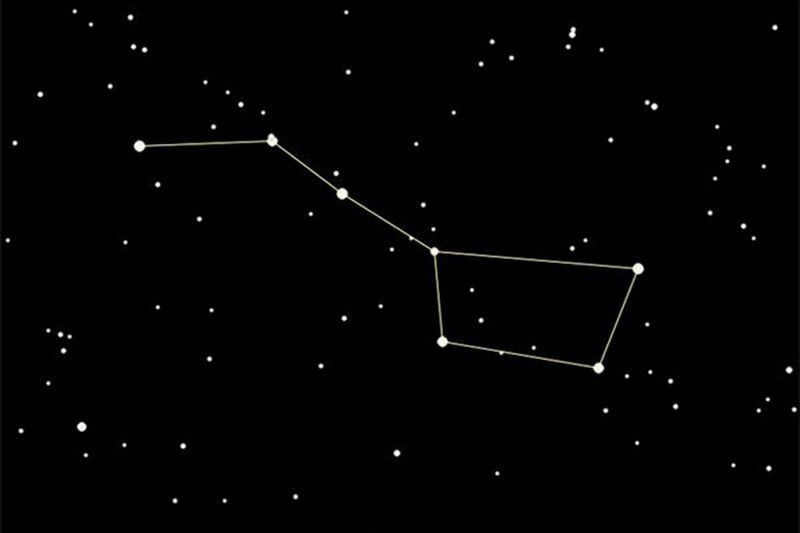
The famous asterism known as the Big Bucket can be found in the Big Dipper.
Clusters can also be part of asterisms – for example, the Pleiades cluster’s brightest stars form a shape similar to a bucket.
The concept of asterism itself is not scientific – it involves the recognition of constellations. These figures simply help with navigation in the night sky, paying homage to a time when people gave memorable groups of stars fitting names, before there was a strict distinction between constellations.
The most notable asterisms in the northern hemisphere
There are numerous asterisms scattered across the celestial sphere. Below, we highlight some of the most renowned and easily recognizable ones:
The Summer Triangle – is composed of Vega, Deneb, and Altair, which are the brightest stars in the constellations Lyra, Cygnus, and Aquila, respectively. This asterism is visible from spring to fall, and during the summer months, it reaches its highest point in the sky, hence its name.
The parallelogram of Lyra – forms a distinct shape within the Lyra constellation, positioned near Vega, resembling a regular parallelogram. Lyra is a summer constellation, so it can be observed from spring through fall.
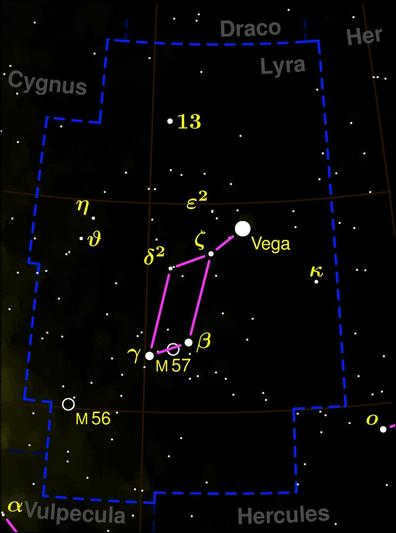
The Northern Cross is a collection of the most brilliant stars found in the Swan constellation, arranged in the shape of a cross. One of the stars included in this constellation is Deneb, which happens to be the brightest star in the entire constellation. Therefore, Deneb is a part of both the Northern Cross and the Summer Triangle simultaneously.
Teapot refers to a pattern created by the stars in the Sagittarius constellation. This particular constellation is situated relatively low above the horizon, making the Teapot fully visible only in the southern regions of the Russian Federation.
Big Bucket is a well-known group of stars within the Big Dipper constellation.
Small Bucket is another renowned formation within the Little Dipper constellation. At the end of its handle lies Polaris.
The constellation Delphinus is characterized by a unique diamond-shaped figure created by its brightest stars, which resemble the body of a dolphin. The remaining stars in the constellation form its tail.
The Spring Triangle is an astronomical formation consisting of three prominent stars: Arcturus, Spica, and Regulus. These stars belong to the constellations Boötes, Virgo, and Leo, respectively, and are among the most luminous in the night sky.
Orion’s Belt is a distinctive feature of the constellation Orion, consisting of three bright stars named Alnitak, Alnilam, and Mintaka. These stars are easily visible and are positioned in a straight line at the center of the constellation.
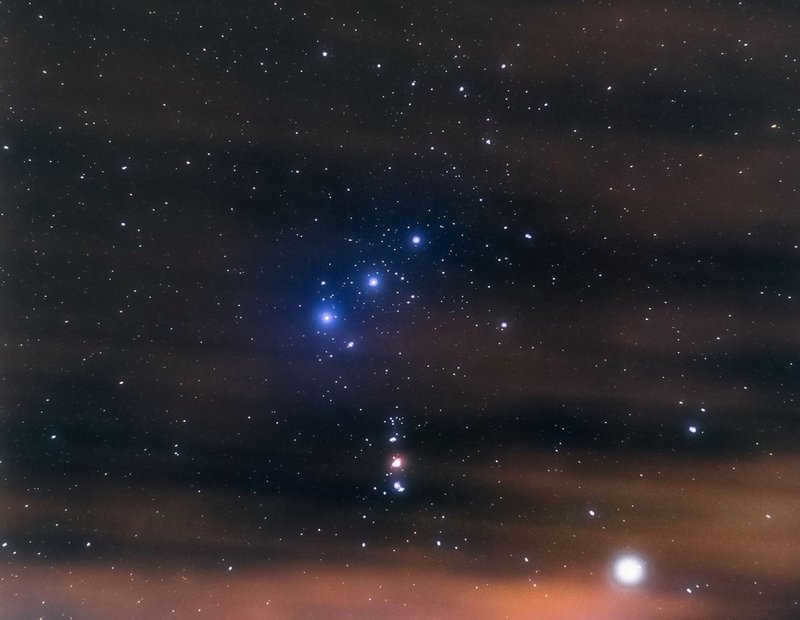
The asterism known as Orion’s Belt is located above the Sword of Orion.
The Pleiades is a cluster that is spread out in the shape of a small dipper, resembling a miniature version of the Big Dipper asterism.
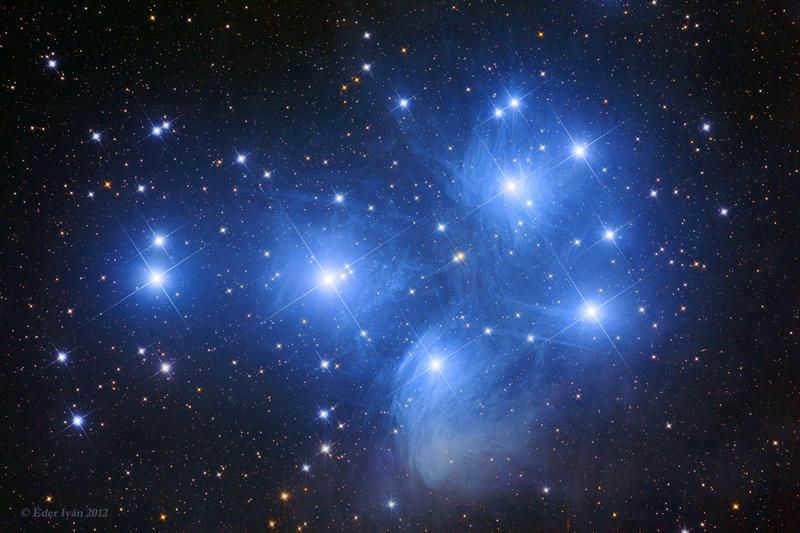
To the unaided eye, the Pleiades cluster appears to resemble a diminutive container.
Naturally, there exist numerous other star patterns that are not as conspicuous. Moreover, when gazing at the celestial expanse, diverse individuals can discern a plethora of distinctive star formations. Presumably, each of these constellations has already acquired its own distinctive appellations.
The Great Summer Triangle: The Ultimate Guide to Navigating the Summer Sky
For amateur astronomers just starting out, one question burns bright: how can I learn to navigate the vast expanse of the night sky?
The answer is surprisingly simple: take it one step at a time. Begin by familiarizing yourself with the brightest stars, learning their names and locations. Then, progress to identifying and locating prominent star patterns. Once you’ve mastered these foundational skills, you can confidently dive into working with star charts. Without a solid understanding of the positions of the brightest stars, using maps for celestial orientation becomes a daunting task. You need that crucial reference point in the sky to align with the detailed maps in an atlas (unless, of course, you have a trusty planisphere).
That’s why we begin with the most basic observations. Step outside on a clear evening, face towards the direction where the Sun is at its highest point in your area around noon – this is south. You don’t need to know the exact south direction at this moment, but you can determine it later using Polaris as a guide.
So, during the twilight hours of the evening, stand facing south and look up. In the night sky, you will notice a prominent triangle shape formed by three bright stars.
During the month of July, as darkness descends, the Great Summer Triangle can be found in the southern part of the sky. See the image below for reference:
The stars Vega and Deneb, which create the foundation of the triangle, will be positioned near the zenith. The apex of the triangle, indicated by the star Altair, is approximately halfway between the zenith and the horizon – the triangle appears to be inverted, appearing upside down.
Before you is one of the most renowned star formations in our celestial sphere. It is referred to as the Great Summer Triangle or the Summer Triangle, sometimes called the Summer-Autumn Triangle. As the name suggests, the optimal time to observe it is during the summer and autumn months, when the triangle is elevated in the southern sky during the evenings.
Being familiar with this star pattern is advantageous for several reasons.
- By studying it, you can gradually become acquainted with all of the summer constellations..
- The Summer Triangle is traversed by the Milky Way. Consequently, Deneb, a star, is situated right in the midst of it. If you manage to locate the Summer Triangle in the night sky, you will automatically determine the position of the Milky Way.
- There are numerous celestial phenomena within and surrounding the boundaries of the Summer Triangle: diffuse nebulae, both diffuse and globular star clusters, as well as double and variable stars.
The path of the Milky Way passes through the Summer Triangle. Illustration: Stellarium
You might have observed that I have referred to the Summer Triangle as a figure and a drawing, but never as a constellation. as a constellation – because it is not a constellation, it is an asterism. asterism. The stars that form the triangle belong to three different constellations. Vega leads the small constellation Lyra, Deneb is part of the very stunning and expressive constellation Cygnus, and Altair is the principal star of the constellation Aquila. All three constellations can be beautifully seen in the rural sky on dark nights in August or September. They are ancient constellations – they are more than 2000 years old.
If you are just starting to familiarize yourself with the starry sky, make sure to look for the Great Summer Triangle – it will be your fundamental star pattern until the end of October.
The Asterism of the Summer-Fall Triangle

The Summer-Fall Triangle is a group of stars called an asterism. It consists of the stars Vega, Altair, and Deneb. These stars are the most visible in the constellations Lyra, Eagle, and Swan, respectively. The asterism is easily distinguished in the summer sky of the northern hemisphere due to its three bright stars. This makes it a useful tool for locating and identifying these stars and their respective constellations, as well as discovering the numerous bright celestial objects that can be found in this part of the sky.
The asterism can be seen throughout the majority of the year for individuals located in the northern hemisphere. However, it becomes particularly prominent during the summer season as it ascends to a high position in the evening sky. Despite the fact that the asterism has been recognized for a significant period of time, its name did not gain widespread popularity until the 1950s, when renowned British astronomer Sir Patrick Moore and American author H. A. Ray popularized the term. In the past, the military utilized the asterism for orientation purposes prior to the invention of GPS systems and other forms of navigation equipment.
Position in the Celestial Sphere
During the summer season in the northern hemisphere, the summer-fall triangle can be found directly above. This configuration of stars can be seen for most of the year from places located north of the equator, with its appearance changing depending on the time of year. In the spring, it is visible in the eastern part of the sky during the early hours of the morning. In the autumn, it can be observed in the western part of the sky during the evening. In the winter, observers located in southern latitudes can spot it low in the northern horizon. When viewed from locations in the southern hemisphere, the summer-fall triangle appears inverted.
Located within the vast expanse of the Milky Way, the summer and fall triangle provides a stunning backdrop for celestial exploration. Utilizing notable stars such as Vega, Altair, Deneb, and other luminous points in the constellations of Lyra, Eagle, and Swan, one can navigate through this region of the sky with ease. These well-known landmarks serve as guides to discover the plethora of dazzling deep space objects that reside here. Among the treasures waiting to be found are the mesmerizing emission nebulae of NGC 7000 and IC 5070, the awe-inspiring planetary nebulae Messier 57 (also known as the Ring Nebula) and Messier 27 (commonly referred to as the Dumbbell Nebula), the captivating globular clusters Messier 56 and Messier 71, and the scattered clusters Messier 11 (famously known as the Wild Duck Cluster) and Messier 26.
The three stars that create the Summer-Fall Triangle are among the most luminous stars in the entire sky. They possess apparent magnitudes of 0.026 (Vega), 0.76 (Altair), and 1.25 (Deneb). Vega is the fifth most brilliant star in the sky and the second brightest star in the northern celestial hemisphere, trailing only behind Arcturus. Altair ranks as the 12th most dazzling star, while Deneb takes the 19th spot.
Vega and Altair exhibit exceptional brightness due to their proximity to our solar system. Vega is a mere 25.04 light-years away, with Altair even closer at 16.73 light-years. Although Deneb shines as a supergiant, it has not yet departed from the main sequence and therefore does not radiate as intensely. Deneb’s brilliance is observed at a distance of 2,615 light-years, earning it a first magnitude magnitude.
All three stars exhibit slight variability. Vega and Altair fall into the category of Delta Shield variables, characterized by fluctuations in brightness caused by both radial and non-radial pulsations on their surfaces. Deneb, on the other hand, serves as the prototype for a distinct group of variable stars known as Alpha Swan variables. These stars, typically A- or B-type supergiants, display small yet rapid changes in brightness resulting from non-radial pulsations, with certain parts of their surfaces expanding while others contract.
The names of all three stars are bird-related. Vega, derived from Arabic, translates to “falling eagle”. Altair, also of Arabic origin, means “flying eagle”. Deneb, on the other hand, refers to the tail of the celestial Swan.

Mythology
In Chinese mythology, the stars Vega, Altair, and Deneb are linked to the popular tale of the Weaver Girl and the Shepherd, which is commemorated every year during the Qixi Festival. According to the legend, the Shepherd, symbolized by Altair, is an orphan who encounters the Weaver Girl, symbolized by Vega. They fall in love and get married, but their union is disapproved by the emperor of heaven, who banishes the Weaver Girl to the celestial realm. The couple is only able to meet once a year, when a bridge made of magpies forms across the Milky Way. In certain versions of the story, Deneb represents the fortieth bridge, while in others, it represents the fairy who accompanies the couple during their reunion. The two stars flanking Altair, Tarazed and Alshain, are believed to represent the children of the Weaver Girl and the Shepherd.
What is an asterism. The most notable asterisms
An asterism refers to a collection of stars that create a distinctive shape or pattern. Essentially, when you observe stars arranged in an interesting manner in the night sky, you are witnessing an asterism. For instance, you may be familiar with the constellation Cassiopeia, which takes the form of the letter W – this is an example of an asterism. Similarly, the Big Dipper resembles a ladle – this shape also falls under the category of asterisms.
One might assume that all constellations can be classified as asterisms, as they all possess certain figures. After all, they are depicted on maps as lines connecting the brightest stars. However, there is a significant distinction to be made.
The distinction between an asterism and a constellation
The key point is that each of the 88 constellations in the sky has well-defined boundaries and occupies a specific area. While the brightest stars within these constellations may form recognizable patterns known as asterisms, not all constellations have prominent asterisms. Some constellations may only have a few bright stars, while others may not have any particularly eye-catching formations.
For instance, in the constellation Pegasus, the bright stars align to form a distinct square, known as the Great Square of Pegasus. On the other hand, the neighboring constellation Andromeda lacks a noticeable asterism, although there is a star from Andromeda located in the left corner of the square.
An asterism can be a smaller component within a constellation. Two well-known examples are Orion’s sword and Orion’s belt, both of which are asterisms found within the same constellation.
Moreover, asterisms can be created from stars that belong to entirely different constellations. An instance of this is the Great Summer Triangle, which comprises the brightest stars in the summer night sky, namely Vega (alpha Lyra), Deneb (alpha Swan), and Altair (alpha Eagle).
Furthermore, there are compact constellations with only a few stars that are sufficiently bright and form a distinct shape. For instance, the majority of stars in the Dolphin constellation actually create the figure of a dolphin. However, it is not considered an asterism since it encompasses almost the entire constellation. Another example is the Northern Crown constellation, where the concepts of asterism and constellation blend, as the asterism encompasses all the bright stars of the constellation.

The famous asterism known as the Big Bucket can be found in the Big Dipper.
Asterisms can even include clusters – for example, the Pleiades cluster’s brightest stars also form a shape resembling a bucket.
The concept of asterism itself is not scientific in nature – it is the constellations that are considered in science. These figures simply help with orienting oneself in the night sky. They are a tribute to the past, when people gave recognizable groups of stars names and the strict delineation of constellations had not yet been established.
The most prominent asterisms in the northern hemisphere
There are numerous asterisms scattered across the night sky. Here, we will highlight some of the most famous and easily recognizable ones:
The Summer Triangle – This asterism is created by three bright stars: Vega, Deneb, and Altair. These stars belong to the constellations Lyra, Cygnus, and Aquila respectively. The Summer Triangle is visible from spring to fall, and during summer nights, it reaches its highest point in the sky, hence its name.
The Lyra Parallelogram – Located near the star Vega, this asterism forms a distinct shape resembling a regular parallelogram within the constellation Lyra. Lyra is a summer constellation, and therefore, it can be observed from spring to fall.

The Swan’s Northern Cross – consists of the most brilliant stars in the Swan constellation, arranged in the shape of a cross. It includes Deneb, which is the brightest star in the constellation. Thus, Deneb is a part of both this asterism and the Summer Triangle simultaneously.
The Sagittarius Teapot – is a pattern formed by the stars in the Sagittarius constellation. This constellation rises close to the horizon, so the Teapot can only be fully seen in the southern regions of the Russian Federation.
The Big Dipper Ladle – is a well-known asterism in the Big Dipper constellation.
The Little Dipper Bucket – is another famous figure in the Little Dipper constellation. Polaris is located at the end of its handle.
The constellation Delphinus consists of stars that create a diamond-shaped pattern resembling the body of a dolphin, with the remaining stars forming its tail.
The Spring Triangle is made up of the stars Arcturus, Spica, and Regulus. These stars belong to the constellations Boötes, Virgo, and Leo, respectively, and are among the brightest in the night sky.
Orion’s Belt is a prominent line of three bright stars (Alnitak, Alnilam, and Mintaka) located in the middle of the Orion constellation.

The Orion’s Belt asterism is located above Orion’s Sword.
The Pleiades is a dispersed cluster that resembles a small dipper, similar to the Big Dipper asterism but on a smaller scale.

The Pleiades cluster is easily recognizable and resembles a tiny bucket even when observed without a telescope.
Naturally, there are numerous other groupings of stars that are not as conspicuous. Moreover, when gazing at the night sky, individuals may perceive various star formations, each of which might already have its own designated names.
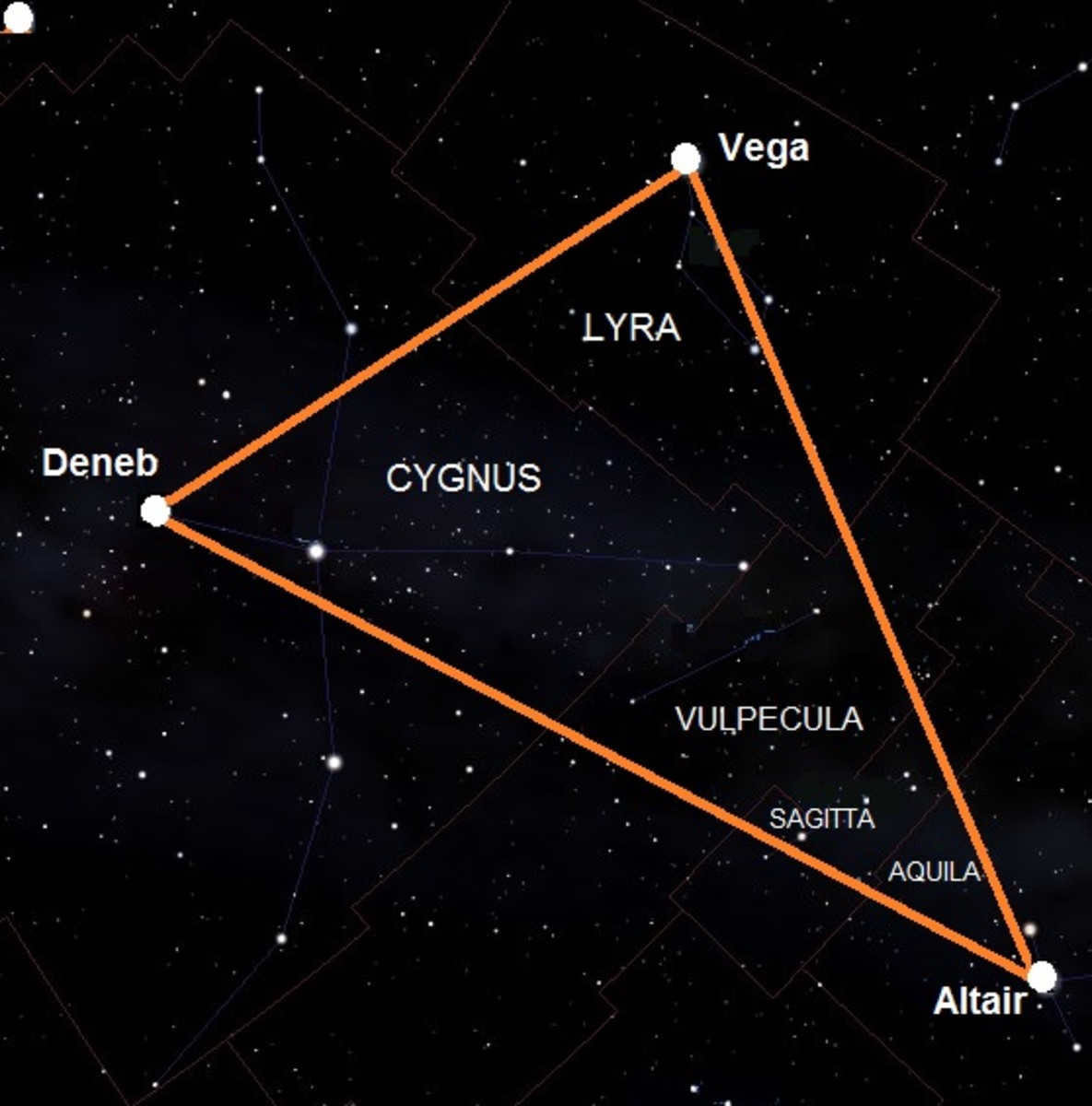
In 1933, the renowned poet W. H. Auden crafted a captivating poem titled “Summer Night,” which commences with the following verses:
Setting aside the poetic merits – of which there are many – it is impossible to fault Auden’s profound understanding of astronomy. On a crystal-clear June evening, as you recline on an English lawn and gaze at the celestial expanse above, you cannot help but be drawn to the radiant star known as Vega, the fifth most luminous star in the entire firmament.
Vega constitutes one point of what is commonly referred to as the Summer Triangle, with the other two points being Altair and Deneb. This celestial triangle, known as an “asterism,” represents an arrangement of stars that falls outside the confines of officially recognized constellations. Altair forms the lowest vertex of the triangle, while Vega occupies the upper right position, and Deneb graces the upper left corner.
Visual Deception
One might easily assume that the constellations and groupings of stars visible to the unaided eye are actual clusters of stars that are relatively close in proximity. However, this is rarely the case, as what we perceive are stars positioned along specific lines of sight when observed from Earth. It is important to note that a star can be significantly farther away from us than its apparent neighbor, and the Summer Triangle serves as a prime example of this phenomenon.
Among the three stars comprising the Summer Triangle, Altair is the nearest to our planet. It is located at a distance of 16.7 light-years, which implies that we perceive it as it appeared 16.7 years ago. On the other hand, Vega is situated 25 light-years away from us, yet it presents itself as slightly more luminous than Altair. This peculiarity can be attributed to the fact that Vega is considerably brighter than Altair, which is a main-sequence dwarf star akin to our Sun. Altair shines with a luminosity 11 times greater than that of the Sun, whereas Vega outshines it with a luminosity 52 times greater, thus giving the impression of being brighter despite its significantly greater distance.
The case of Deneb is even more remarkable. Its apparent brightness is three times lower than that of Vega, but this is because it is neither too far nor too close. Experts believe that Deneb could be located anywhere between 1,550 and 2,600 light-years away. If it were a star of the same type as Vega or Altair, it would be completely invisible to the naked eye. However, Deneb is not an ordinary star. It is a white supergiant with a diameter 200 times larger than our Sun and shines 200,000 times brighter. If Deneb were positioned at the same distance as Vega, it would emit such a powerful light that it could cast shadows at night and be visible during the day!
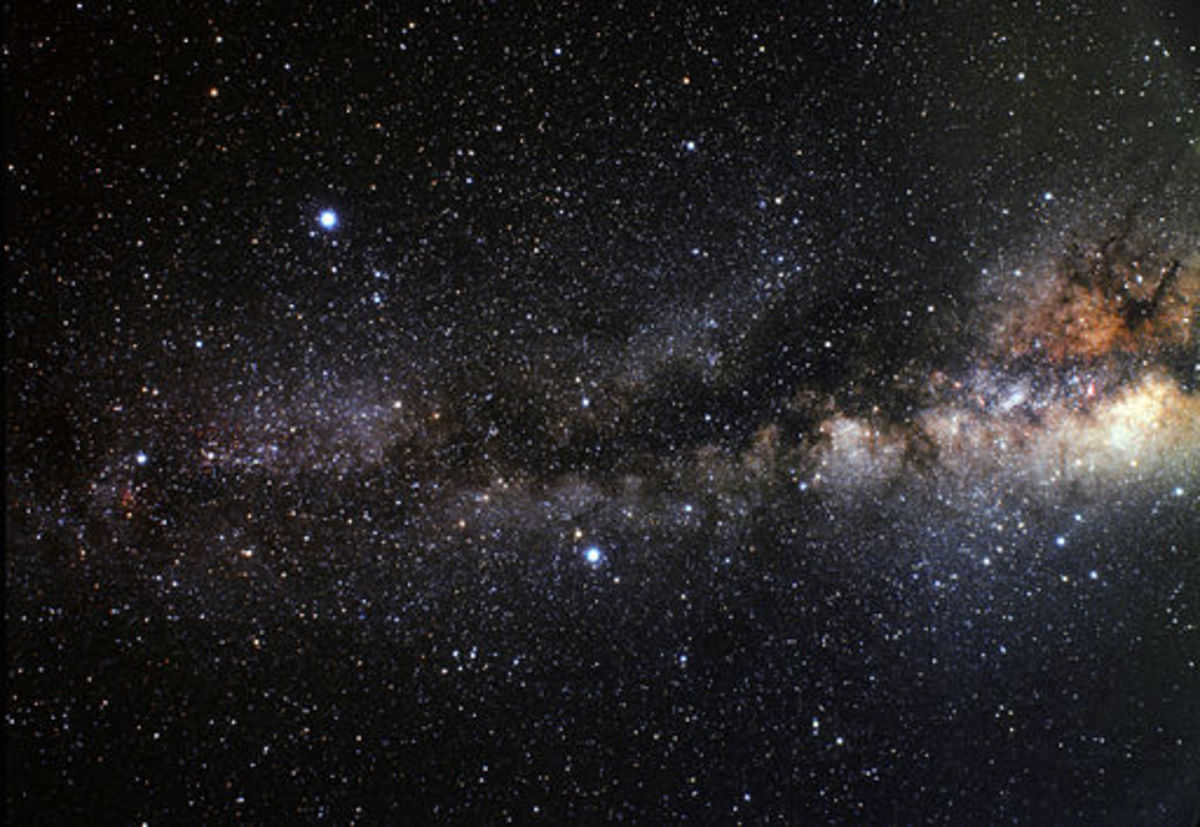
The constellation known as the Summer Triangle contains three of the brightest stars in the sky: Vega, Deneb, and Altair. These stars form a distinctive triangle shape that is easily recognizable in the summer months.
Summer Triangle and the Milky Way
One of the most fascinating aspects of the Summer Triangle is its connection to the Milky Way, the galaxy in which our solar system resides. When the sky is dark and the Moon is not casting its brightness, observers of the Summer Triangle can witness the awe-inspiring sight of the Milky Way stretching across the triangle, appearing to bridge the gap between Vega and Altair. This phenomenon becomes even more stunning when observed through a telescope, revealing the intricate details and vastness of our galaxy.
This “river” represents the combined luminosity emitted by the numerous celestial bodies constituting a portion of our galaxy. Due to the tilt of the Earth, observers in the northern hemisphere can only direct their gaze “outward,” while those in the southern hemisphere have the opportunity to look “inward,” towards the galactic core. This restriction does not significantly hinder northern viewers, as our Sun resides in one of the outer vortices of the Galaxy (Orion’s Arm). Consequently, there is plenty to observe within our own vortex, including swirling formations such as the arms of Perseus and the Swan, and even beyond.
Alberio
This celestial body is situated to the left of the imaginary line connecting Vega and Altair, approximately in the middle of that line. It is visible to the naked eye, but when observed through a modest telescope, it becomes apparent that Alberio is actually a binary star system, with the two components having distinct colors: Beta Cygni A appears yellow, while Beta Cygni B appears blue-green. Some astronomers have proposed that Beta Swan A itself may be a binary star, which would make Alberio a three-star system.
However, the scientific community has yet to reach a definitive conclusion regarding whether Alberio is a genuine double/triple star system, with its components orbiting a common center of gravity, or if it is merely an optical double, with Beta Swan A and Beta Swan B appearing close together only from our perspective.
Epsilon Lyrae
If there are any inquiries regarding the composition of Alberio, there are absolutely no doubts about Epsilon Lyrae, which is in close proximity (visually) to Vega. It is a genuine “double double”, with the two primary components also being doubles. You will require exceptional visual acuity – or modest binoculars – to discern the primary division, but a much more powerful telescope is necessary to observe the system in its entirety – approximately 200x magnification in a four-inch aperture telescope should suffice!
The separation between the two primary components in Epsilon Lyrae is of a vastly different magnitude – 10500 astronomical units. When assessed within the framework of its own stellar system, this measurement may seem like an immense distance; nevertheless, when one takes into account the fact that the proximity to Proxima Centauri, the closest neighboring star to the Sun, spans 268,000 astronomical units, the stars of Epsilon Lyrae seem to be in close proximity to each other!
Nebulae M57 and M27
Two remarkable planetary nebulae can be observed within the Summer Triangle. When viewed with lower-resolution equipment, these nebulae appear like fuzzy stars. However, with the aid of a high-quality telescope, their true nature is unveiled – the outer layers of an ancient red giant star that has reached the end of its life and transformed into a white dwarf.
M57, also known as the Ring Nebula, is positioned approximately halfway between Vega and Alberio, slightly to the right of the imaginary line connecting them. By utilizing a telescope with an aperture of three inches or larger, viewers can witness the vibrant colors of what has been described as a “celestial smoke ring”. M57 is situated 2,300 light-years away.
Alberio is located midway between the M57 and M27 nebulas, also known as the Dumbbell Nebula. It is larger and brighter compared to M57 and is situated at a distance of 1,360 light-years from us. Alberio is more easily detectable than M57 and holds the distinction of being the first planetary nebula to be identified. According to estimates, the original red giant star shed its outer layers approximately 14,500 years ago, leaving behind its core as a white dwarf. This white dwarf is currently the largest of its kind ever discovered.
Investing time observing the Summer Triangle through a medium-power telescope will yield great rewards!
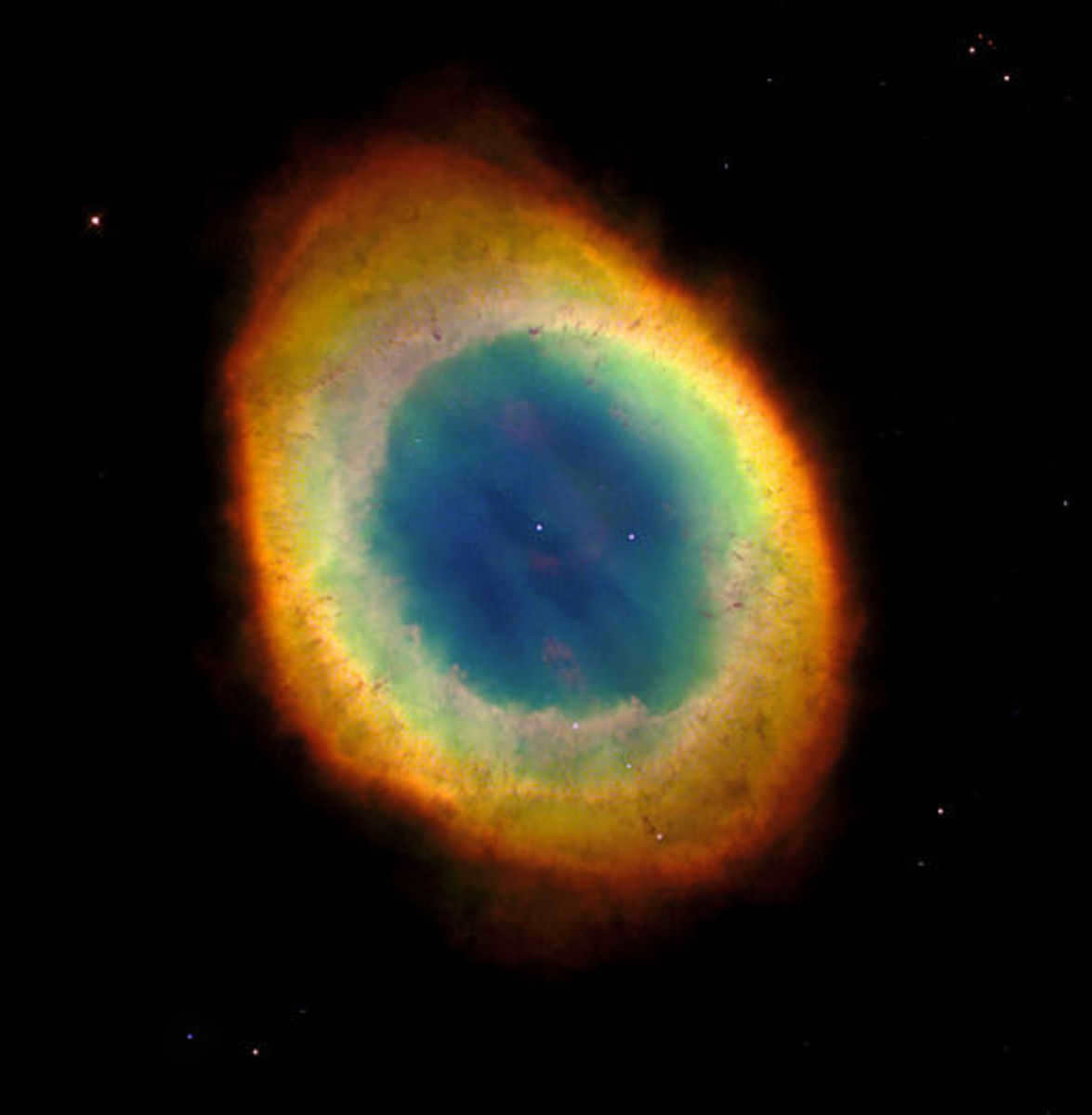

The Hubble Space Telescope
